Canadians have been flocking to Portugal for years, and it’s no wonder: it’s a Western European country with Eastern European prices, has enough attractions to keep a visitor busy for months on end, is overflowing with delicious and affordable food and wine, and is stunningly beautiful. Add to that, both Lonely Planet and Rough Guides named Portugal a best value destination in 2014.
When I started mentioning to friends and acquaintances that we were going to be spending eight weeks in Portugal, they naturally (and much to our delight) started offering advice and recommendations. We were surprised, however, that most of the recommendations focused on destinations in the central and northern regions of Portugal; but what about the south? While Canadians indeed love Portugal, it seems many of us stick to the well-worn path of Lisbon, Porto, and the historic towns and regions nearby. And while there is nothing wrong with these places—Lisbon is one of my favourite cities and Porto is undeniably charming—there is so much more to Portugal. With that in mind, I thought I’d take some time to share highlights of Portugal’s extreme south: welcome to the Algarve!
-
The Architecture (and by architecture, I really mean the ornamental chimneys!)
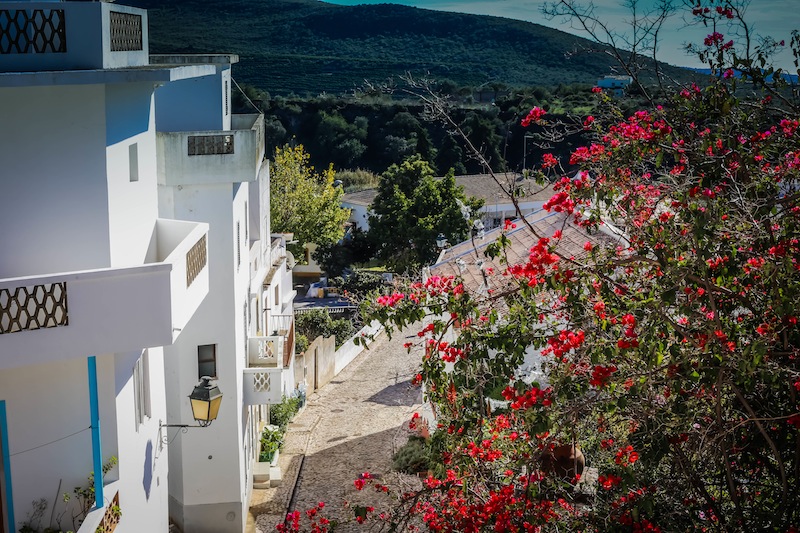
The picturesque village of Alte, Portugal, is known for having beautiful homes built in the traditional style of the Algarve.
The Algarve is known to have a distinctive architectural style, which can be seen in villages and towns throughout the region. Squat, whitewashed homes pop against the Algarve’s characteristic blue skies. Strange as it sounds, Algarvian roofs are something to behold: gently sloped, they are typically covered in rounded red clay tiles, with beautiful ornamental chimneys and decorative vases popping from their tops like heirloom stars atop a Christmas tree. While each home looks more or less the same, the chimneys—sometimes homes have three or four—are unique, adding distinctive character to each home.

A typical Algarvian chimney can be seen behind a red tiled roof in Alte, Portugal
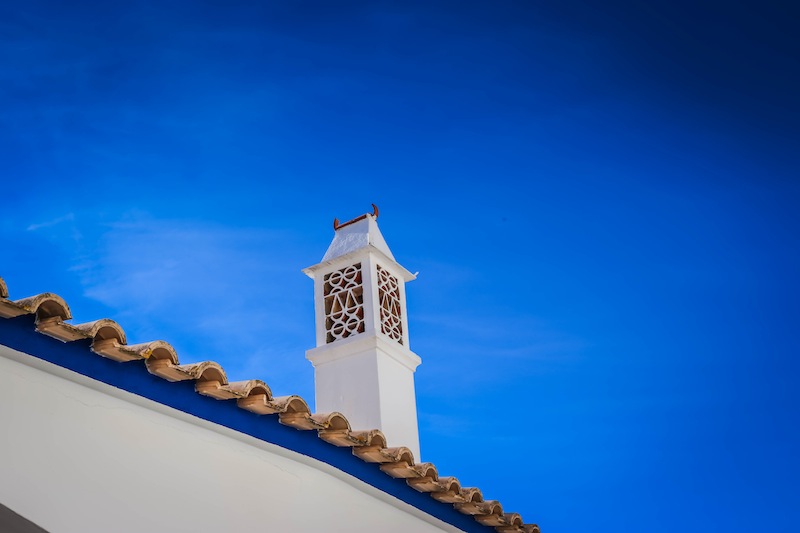
A typical chimney in Alte, Portugal
It would be nearly impossible to visit the Algarve without seeing these beautiful chimneys, but some towns are known for their exceptional Algarvian architecture and chimneys. The tiny town of Alte is known for having some of the best examples of traditional architecture out there, and the homes are highly photogenic. The town is sleepy, but beautiful, and it’s easy to spend a few hours wandering through the narrow streets, taking photographs every few steps. Estoi is another town known for its architecture and chimneys.
Further reading: Saudi Aramco World has a feature article about the history of the Algarvian chimneys available on the website; it is well worth the read if you want to learn more about these beautiful examples of craftsmanship! -
The Sea (with spectacular beaches and views)

For many people, the gloriously blue Atlantic ocean is reason enough to visit the Algarve. Northern European sun-seekers visit the Algarve in droves during the winter, gorging on a week’s worth of Vitamin D to last them through the winter. However, it’s even more popular in summer, where the beaches are literally packed full of sun-seekers.
Although the coastal towns and beaches of the Algarve share the same 155 kilometres of Atlantic coastline, towns and cities in the eastern and western halves of the region exhibit radically different characters. The west is much more developed and resort-like, whereas the east is wilder, with unkept and lonely stretches of beaches and cliffs.
If lounging on the beach is too sedentary an activity for you, there are some beautiful hikes in the Western Algarve. If it is spectacular scenery you’re after, make the drive to Cabo St. Vincent (Cape St. Vincent, in English), just past Sagres, in the extreme southwest of Portugal. Historically, this area was known as the end of the known world, and played an important part in Portuguese history: it was from here that many of Portugal’s successful sea explorations were planned. Today, it is home to spectacular vistas of the wild Atlantic, and a historic fort on the edge of the world.
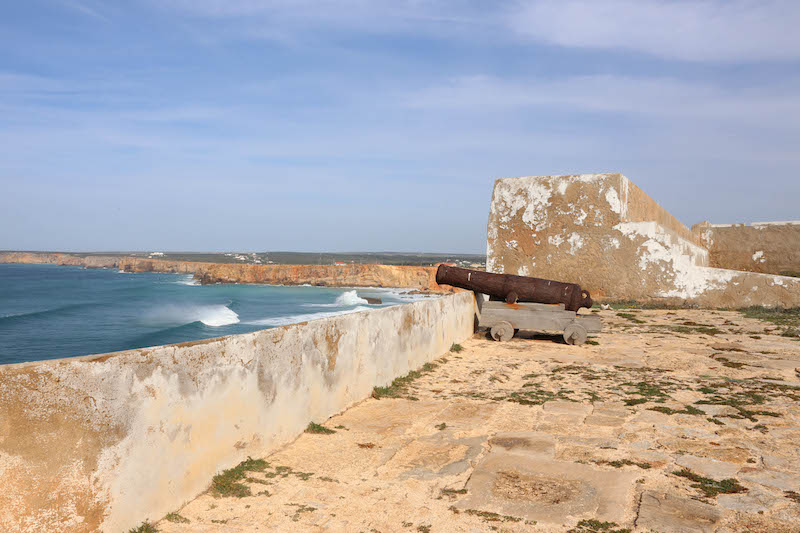
The Atlantic Ocean, as seen from Cape St. Vincent near Sagres, is particularly rough and wild, off the coast of southwestern Portugal. -
The Groves (and resultant fresh oranges, olives, pomegranates…)

Travel slightly inland from the ocean, and you’ll find yourself in a world of rolling green hills covered in olive trees.
If you pull yourself away from the coast for long enough to drive just slightly north, you’ll find yourself in an Algarve that looks drastically different from the golden cliffs and beaches next to the Atlantic: rolling green hills and valleys, with herds of sheep and goats grazing. If someone asked me to conjure an image of Southern Europe, the image would look exactly like the olive and orange grove covered hills of the inland Algarve. Indeed, the Algarve’s Mediterranean climate means that temperatures almost never go below freezing. As such, the Algarve is a productive agricultural region with succulent oranges, pomegranates, figs and lemons tempting you from the roadside, begging to be plucked straight from the tree. Olive groves abound, and high quality olive oil is inexpensive.

It’s hard to beat oranges plucked straight from the tree!
If you head to the Algarve during the winter, you’re in luck: orange season. On the N125 highway near Albufeira (there were many on the road heading towards Loulé), local farmers line both sides of the street, selling their oh-so-fresh citruses: clementines, tangerines, oranges…there are several different varietals at each stand. The oranges are incredibly fresh and cheap – typically €1 or €2 for one kilogram. If—in your haste to pack for your vacation—you forgot to pack your juicer, fear not: most restaurants and cafés have industrial juicers, which will squeeze you a glass of the good stuff in no time, and for a very reasonable price. -
The towns and cities (and the relaxed lifestyle of Southern Europe)
If you come to the Algarve looking for a big city feel, you’ll likely be disappointed. However, if you’re open to a pace of life that is slower and more relaxed, then you may be pleasantly surprised by the towns and cities in the Algarve.
Tavira was hands-down our favourite city in the Algarve. Located in the eastern half of the region, it straddles the mouth of the dually-named Rio Séqua/Gilão River as it spills into the Atlantic. Tavira is a city of churches—it has nearly 40 of them—but we found the real appeal to be the ambience. After visiting the castle (which is free to visit) and a few churches, grab a coffee at one of the many outdoor cafes near the riverfront and main square, then take a stroll along the water, crossing the Ponte Romana, an ancient bridge that linked Tavira to the border post of Castro Marimduring Roman times.
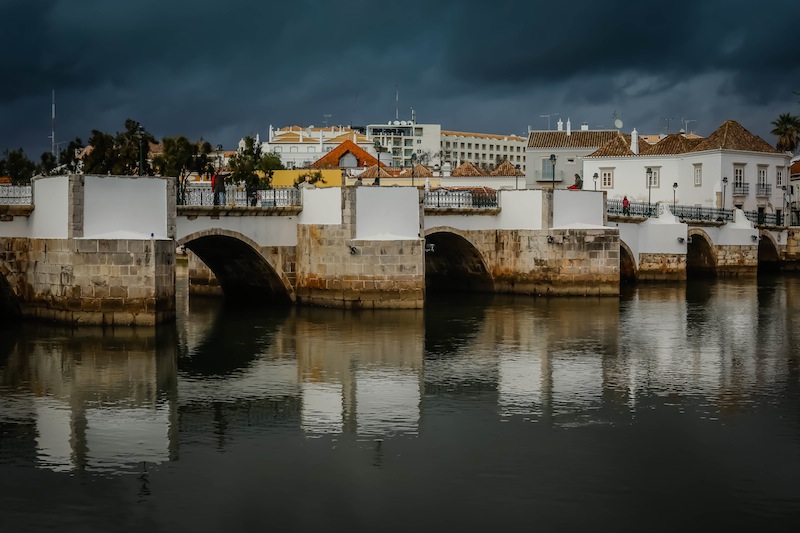
The Roman Bridge in Tavira dates back to ancient Rome, but was re-built in the 17th Century due to damage incurred by flooding.
Depending on your preferences, the cities of Lagos, in the west, and Albufeira, in the middle-west, will either delight or appall you. Albufeira is a package vacation hotspot, and if you spend any time there, you’ll likely to be in the company of vacationing Brits and northern Europeans. As with many popular destinations, it is popular for a reason: Albufeira is beautiful, with whitewashed buildings built into steep hills, the town falling away dramatically as golden cliffs drop to a sandy beach. However, with its beauty comes a plethora of tattoo shops, over-the-top tourist souvenir shops, and bars and restaurants offering bangers and mash. Lagos is similar, but for the surfer and backpacker crowd. We visited in the offseason, and it was actually quite tame. But Lagos is known for its partying culture, which may or may not be of interest.
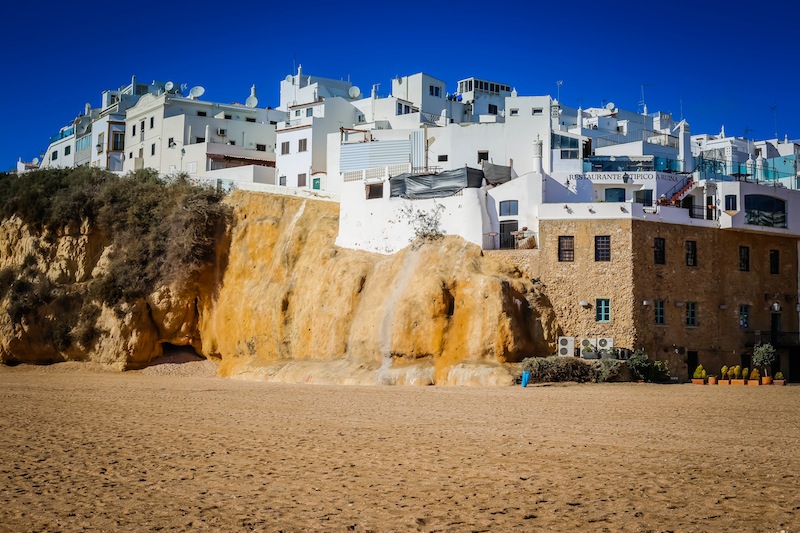
Albufeira, Portugal is popular with tourists for good reason: it is undeniably beautiful!
If you want to get off the tourist trail, the small city of Loulé may be a good bet. Loulé has a small but pretty castle and a compact old town that’s good for a quiet afternoon wander. Although Loulé lacks the dazzle that makes places like Albuferia and Lagos more popular with tourists, it’s a good place to watch regular Portuguese people go about their lives (the Saturday market is a great stop if you’re self-catering, as you can pick up a plethora of farm-fresh produce). -
The History (and the remaining legacy of a mash-up of civilizations)
The Algarve—like the rest of Portugal—is a region rich in history, with evidence of inhabitants all the way back to the Paleolithic and Neolithic periods. The Roman Empire stretched into the Algarve, as did the Moors from North Africa, and finally the Christian re-conquests.
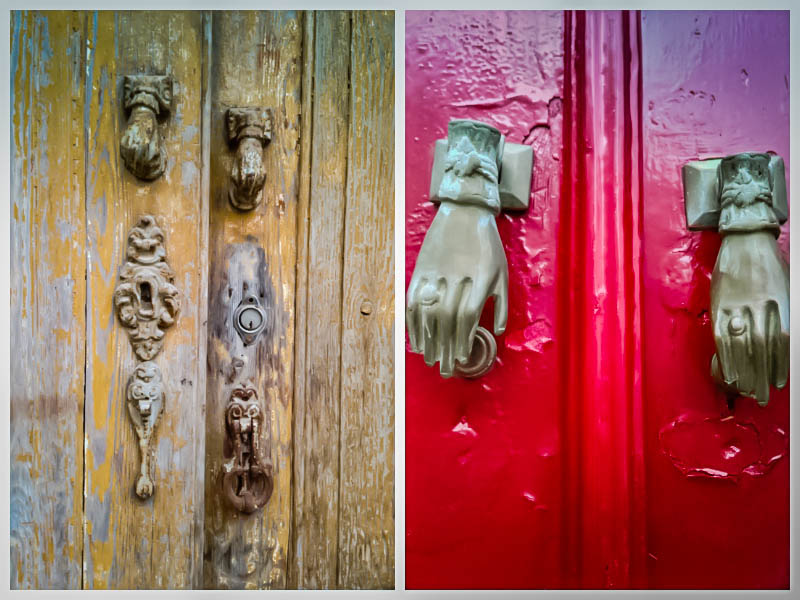
Moorish influences, such as these door knockers in the shape of a female hand, are still visible today.
The Milreu Roman ruins, on the outskirts of Estoi, is an interesting example of what rural areas would have looked like during the 2nd and 1st centuries of Roman rule. The ruins near Estoi show a typical Roman villa rustica—a small farming centre—which would have played an important role in producing food for the resident population and Roman army. For better or worse, visitors have a surprisingly high level of access to the ruins, with only small areas cordoned off completely.

The mosaics at the Milreu ruins are particularly well-preserved, and are roped off to protect them
Castro Marim, which is just across the Guadiana River from Spain, is another interesting stop for history buffs. Dating back to around 5,000 BC, Castro Marim was an important port town along the river, serving as a stop for ships carrying copper from nearby mines. The town itself is nestled between two hilltops, with a castle and fort overlooking the town from either side. If you’re interested in learning more about Castro Marim’s history, this video is a good start:
Tips for Travelling Through Portugal’s Algarve:
- Coming from Canada, I sometimes find we have a skewed sense of the relationship between time and distance – Canada is so large, it’s easy to fall into a trap by assuming somewhere is simply too far for a day trip. However, the Algarve is pretty small, and almost everything is accessible in a day trip, especially if you base yourself somewhere in the middle.
- If you’re in a hurry, and don’t mind spending money on road tolls, the A22 is a newish highway that is in excellent condition, and allows you to travel at up to 120km per hour. Tolls can be paid at any post office within a few days of taking the road, or your rental company will pay the toll, and bill you at the end (with, in all likelihood, a surcharge for the convenience—ask upon pick-up). If you have more time or are more budget conscious, you can easily avoid the toll roads by taking secondary and tertiary roads.
- Car rental is reasonably priced in Portugal, especially for longer stays. However, be forewarned: Portugal is a nation of notoriously aggressive tailgaters, so you’ll have to prepare yourself.
- House sitting opportunities are plentiful within the Algarve, as many expatriates like to return to their home country for several weeks or months at a time. If you’re looking for an inexpensive way to stay in the Algarve from one week to up to several months, you may want to consider house sitting.
- Health care is good in Portugal, with both public and private hospitals. However, they can be expensive, making a good travel insurance policy a must in case of emergencies.


This a great article and good advice for visitors to Portugal. We have many Canadian visitors to Lagos and the western Algarve – don’t agree that The beautiful historic city of Lagos is a party town! In fact he you want nightclubs etc you would be best to head to Albufeira! Other great locations are Burgau, Liz & Salema with stunning countryside & beaches.April/ May & June are good months to see the carpet of wild flowers in the national park which covers the area. from Burgau, west to Sagres and northwards up the west coast.
Yeah ! That´s Algarve. An amazing place to be with a rich history.
Next time you visit this region take a look at Algarve Villas near Almancil, and discover and magic place.